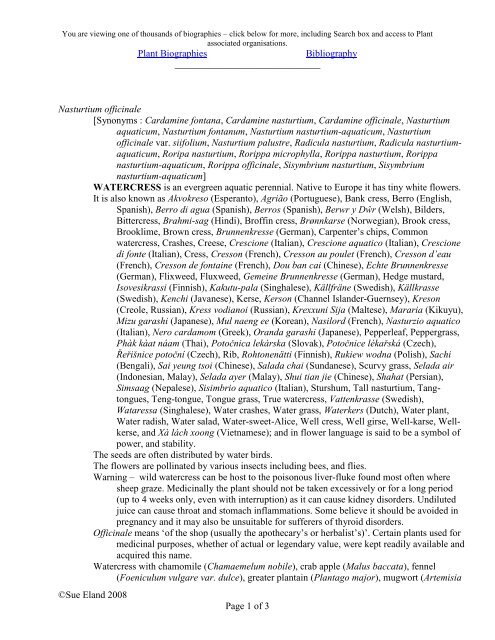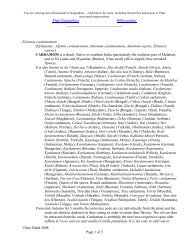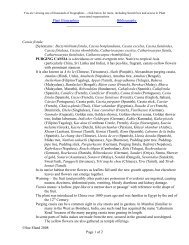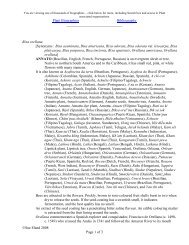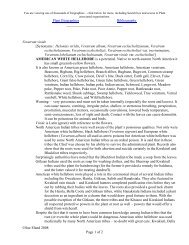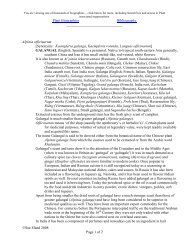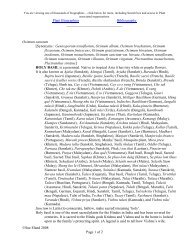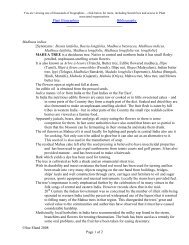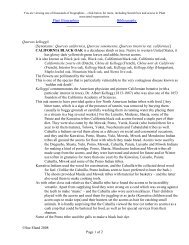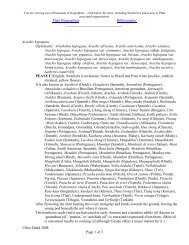watercress - Plant Biographies
watercress - Plant Biographies
watercress - Plant Biographies
Create successful ePaper yourself
Turn your PDF publications into a flip-book with our unique Google optimized e-Paper software.
You are viewing one of thousands of biographies – click below for more, including Search box and access to <strong>Plant</strong><br />
associated organisations.<br />
<strong>Plant</strong> <strong>Biographies</strong> Bibliography<br />
______________________________<br />
Nasturtium officinale<br />
[Synonyms : Cardamine fontana, Cardamine nasturtium, Cardamine officinale, Nasturtium<br />
aquaticum, Nasturtium fontanum, Nasturtium nasturtium-aquaticum, Nasturtium<br />
officinale var. siifolium, Nasturtium palustre, Radicula nasturtium, Radicula nasturtiumaquaticum,<br />
Roripa nasturtium, Rorippa microphylla, Rorippa nasturtium, Rorippa<br />
nasturtium-aquaticum, Rorippa officinale, Sisymbrium nasturtium, Sisymbrium<br />
nasturtium-aquaticum]<br />
WATERCRESS is an evergreen aquatic perennial. Native to Europe it has tiny white flowers.<br />
It is also known as Akvokreso (Esperanto), Agrião (Portuguese), Bank cress, Berro (English,<br />
Spanish), Berro di agua (Spanish), Berros (Spanish), Berwr y Dŵr (Welsh), Bilders,<br />
Bittercress, Brahmi-sag (Hindi), Broffin cress, Brønnkarse (Norwegian), Brook cress,<br />
Brooklime, Brown cress, Brunnenkresse (German), Carpenter’s chips, Common<br />
<strong>watercress</strong>, Crashes, Creese, Crescione (Italian), Crescione aquatico (Italian), Crescione<br />
di fonte (Italian), Cress, Cresson (French), Cresson au poulet (French), Cresson d’eau<br />
(French), Cresson de fontaine (French), Dou ban cai (Chinese), Echte Brunnenkresse<br />
(German), Flixweed, Fluxweed, Gemeine Brunnenkresse (German), Hedge mustard,<br />
Isovesikrassi (Finnish), Kakutu-pala (Singhalese), Källfräne (Swedish), Källkrasse<br />
(Swedish), Kenchi (Javanese), Kerse, Kerson (Channel Islander-Guernsey), Kreson<br />
(Creole, Russian), Kress vodianoi (Russian), Krexxuni Sija (Maltese), Mararia (Kikuyu),<br />
Mizu garashi (Japanese), Mul naeng ee (Korean), Nasilord (French), Nasturzio aquatico<br />
(Italian), Nero cardamom (Greek), Oranda garashi (Japanese), Pepperleaf, Peppergrass,<br />
Phàk kàat náam (Thai), Potočnica lekárska (Slovak), Potočnice lékařská (Czech),<br />
Řeřišnice potoční (Czech), Rib, Rohtonenätti (Finnish), Rukiew wodna (Polish), Sachi<br />
(Bengali), Sai yeung tsoi (Chinese), Salada chai (Sundanese), Scurvy grass, Selada air<br />
(Indonesian, Malay), Selada ayer (Malay), Shui tian jie (Chinese), Shahat (Persian),<br />
Simsaag (Nepalese), Sisimbrio aquatico (Italian), Sturshum, Tall nasturtium, Tangtongues,<br />
Teng-tongue, Tongue grass, True <strong>watercress</strong>, Vattenkrasse (Swedish),<br />
Wataressa (Singhalese), Water crashes, Water grass, Waterkers (Dutch), Water plant,<br />
Water radish, Water salad, Water-sweet-Alice, Well cress, Well girse, Well-karse, Wellkerse,<br />
and Xà lách xoong (Vietnamese); and in flower language is said to be a symbol of<br />
power, and stability.<br />
The seeds are often distributed by water birds.<br />
The flowers are pollinated by various insects including bees, and flies.<br />
Warning – wild <strong>watercress</strong> can be host to the poisonous liver-fluke found most often where<br />
sheep graze. Medicinally the plant should not be taken excessively or for a long period<br />
(up to 4 weeks only, even with interruption) as it can cause kidney disorders. Undiluted<br />
juice can cause throat and stomach inflammations. Some believe it should be avoided in<br />
pregnancy and it may also be unsuitable for sufferers of thyroid disorders.<br />
Officinale means ‘of the shop (usually the apothecary’s or herbalist’s)’. Certain plants used for<br />
medicinal purposes, whether of actual or legendary value, were kept readily available and<br />
acquired this name.<br />
Watercress with chamomile (Chamaemelum nobile), crab apple (Malus baccata), fennel<br />
(Foeniculum vulgare var. dulce), greater plantain (<strong>Plant</strong>ago major), mugwort (Artemisia<br />
©Sue Eland 2008<br />
Page 1 of 3
vulgaris), stinging nettle (Urtica dioica), thyme (Thymus vulgaris) and wood betony<br />
(Stachys officinalis) was one of the Nine Sacred Herbs for the Anglo-Saxons. (Some<br />
authorities believe that the ninth could have been sainfoin, Onobrychis viciifolia.) They<br />
believed that the plants could give protection against evil.<br />
It was used as a strewing herb.<br />
If traditional stories are to be believed the Greek historian and military commander, Xenophon<br />
(c.435-354) who early in his career served as a Greek mercenary under the Persian<br />
prince, Cyrus the Younger (424-401 BC) is said to have promoted <strong>watercress</strong> among the<br />
Persians he met at that time. It was a familiar plant to both the ancient Greeks and the<br />
Romans and the latter are understood to have considered it as a desirable part of diets for<br />
the mentally ill.<br />
Both medicinal and aromatic qualities of <strong>watercress</strong> (probably collected from the wild) were<br />
recognized by the Romans and it has been cultivated in northern Europe, particularly<br />
France and the Netherlands, for centuries. It seems that the first commercial <strong>watercress</strong><br />
beds to be established in England only made their appearance in Kent in about 1808.<br />
More are said to have followed quite quickly in the counties surrounding London for<br />
which they primarily catered. Some of the track of the old railway lines that was laid<br />
specifically to carry the fresh plant to the metropolis from places further afield still exists.<br />
One example is that from Arlesford in Hampshire where <strong>watercress</strong> beds are still thriving<br />
and the line is familiarly known today as the ‘Watercress Line’.<br />
In Britain many used to believe that <strong>watercress</strong> should not be harvested when there was an ‘R’<br />
in the month. This in effect excluded the Summer months and authorities seem to be of<br />
two minds as to whether it was explained by the fact that wild <strong>watercress</strong> flowers then –<br />
or that at that time water levels could be lower and the water less free-flowing which<br />
might lead to a dirty crop.<br />
Although today the leaves are familiar as a salad and flavouring they used to be cooked like<br />
spinach (Spinacia oleracea) even as recently as the 1930s.<br />
Fishermen are said to welcome <strong>watercress</strong> especially in trout streams as it attracts many of the<br />
creatures the fish feed upon. Watercress is also much enjoyed by ducks.<br />
Unusually for a salad plant <strong>watercress</strong> has heraldic connections. (If one overlooks the<br />
illogicality as it ignores the fact that <strong>watercress</strong> grows in running water the following tale<br />
is delightful.) The story goes that while out hunting in the Summer heat in the<br />
countryside north-west of Paris the French king, Louis IX (otherwise known as St. Louis)<br />
(1215-1270) became desperate for a drink. He was offered <strong>watercress</strong> to quench his thirst<br />
(as it is said that no liquid was near) and was so pleased by its refreshing taste that he<br />
wanted to commemorate the little plant and the place where it was found. Coincidentally<br />
or not the French city of Vernon claims that its coat of arms dates back to the 13<br />
©Sue Eland 2008<br />
Page 2 of 3<br />
th<br />
Century and this contains three bunches of <strong>watercress</strong>.<br />
At some point the plant reached North America and there it came to be known by several North<br />
American Indian tribes. The Cherokee, Havasupai, Okanagan-Colville, some of the<br />
Algonkin, the Saanich, Diegueño, Luiseño , Gosuite, Cahuilla, Tubatulabal, Kawaiisu,<br />
Iroquois and Karok tribes all ate it as a vegetable particularly in salads. The Mendocino<br />
Indian tribe viewed it more as a relish, and records suggest that the Okanagan-Colville<br />
relied upon it especially as a famine food. It was also a source of medicine for several<br />
tribes. Apparently the Okanagan-Colville applied it fresh to the forehead in poultices to<br />
ease both headaches and dizziness. Both the Mahuna and Costanoan Indians valued it for<br />
treating liver problems, and the latter also used it to ease fever and kidney disorders.<br />
Watercress is prized by the cosmetics industry as it can help to make the skin smooth and white<br />
– and it can be an ingredient in bath gels.<br />
The juice is used by the tobacco industry as a nicotine solvent.
Medicinally, countries identify a wide range of differently valued qualities that include a<br />
remedy for asthma and scurvy, and use as a contraceptive, purgative and aphrodisiac. It is<br />
also said to have gained a reputation in bygone days for being able to alleviate a<br />
hangover. Watercress is a rich source of Vitamins A and C as well as beta-carotene. It is<br />
understood that the American Cancer Society believes that a diet consisting of a high<br />
content of plants that contain beta-carotene can assist in reducing the risk of contracting<br />
some forms of cancer. The plant is used in proprietary medicines today.<br />
It is the birthday flower for 24 th September.<br />
©Sue Eland 2008<br />
Page 3 of 3


